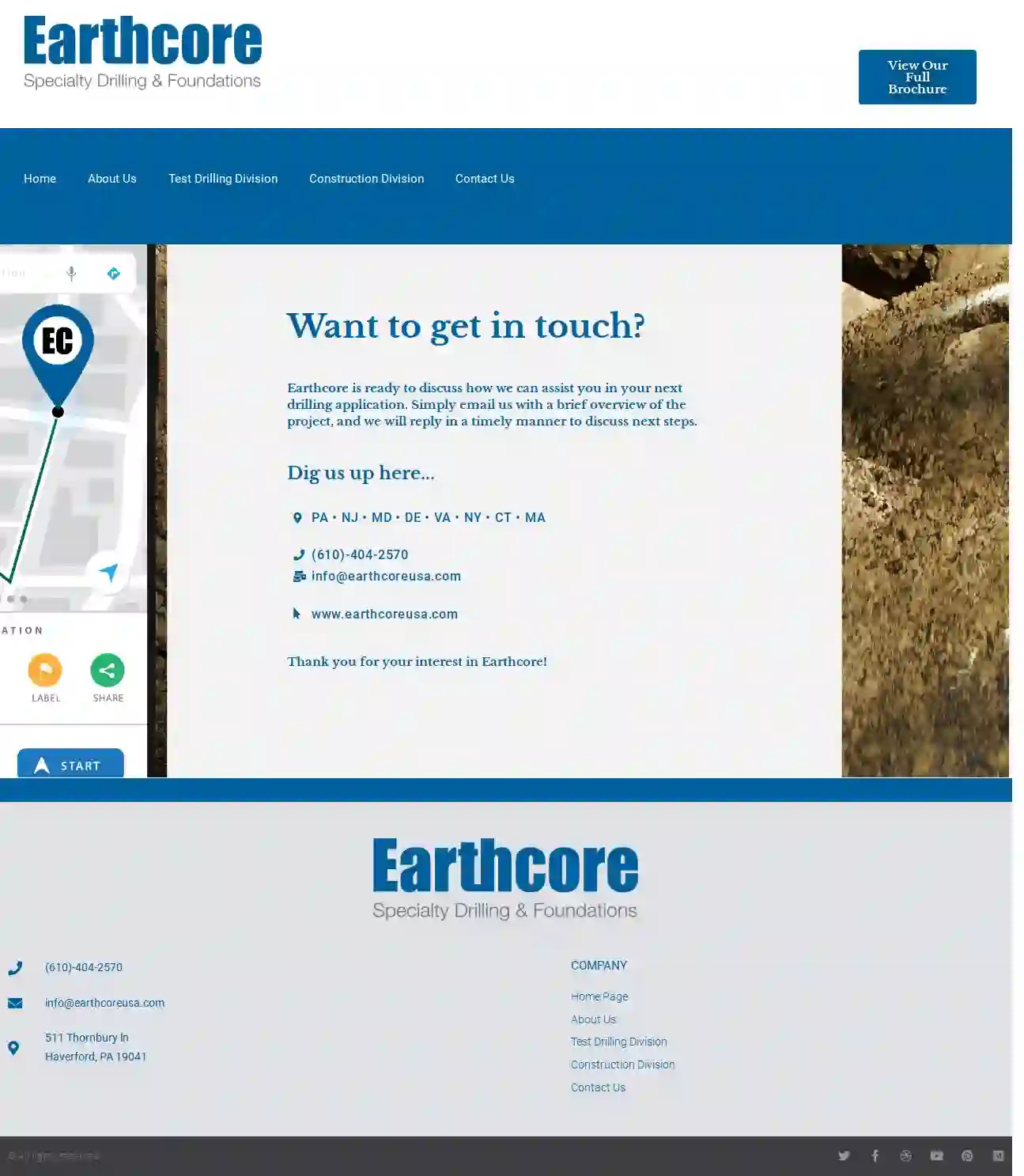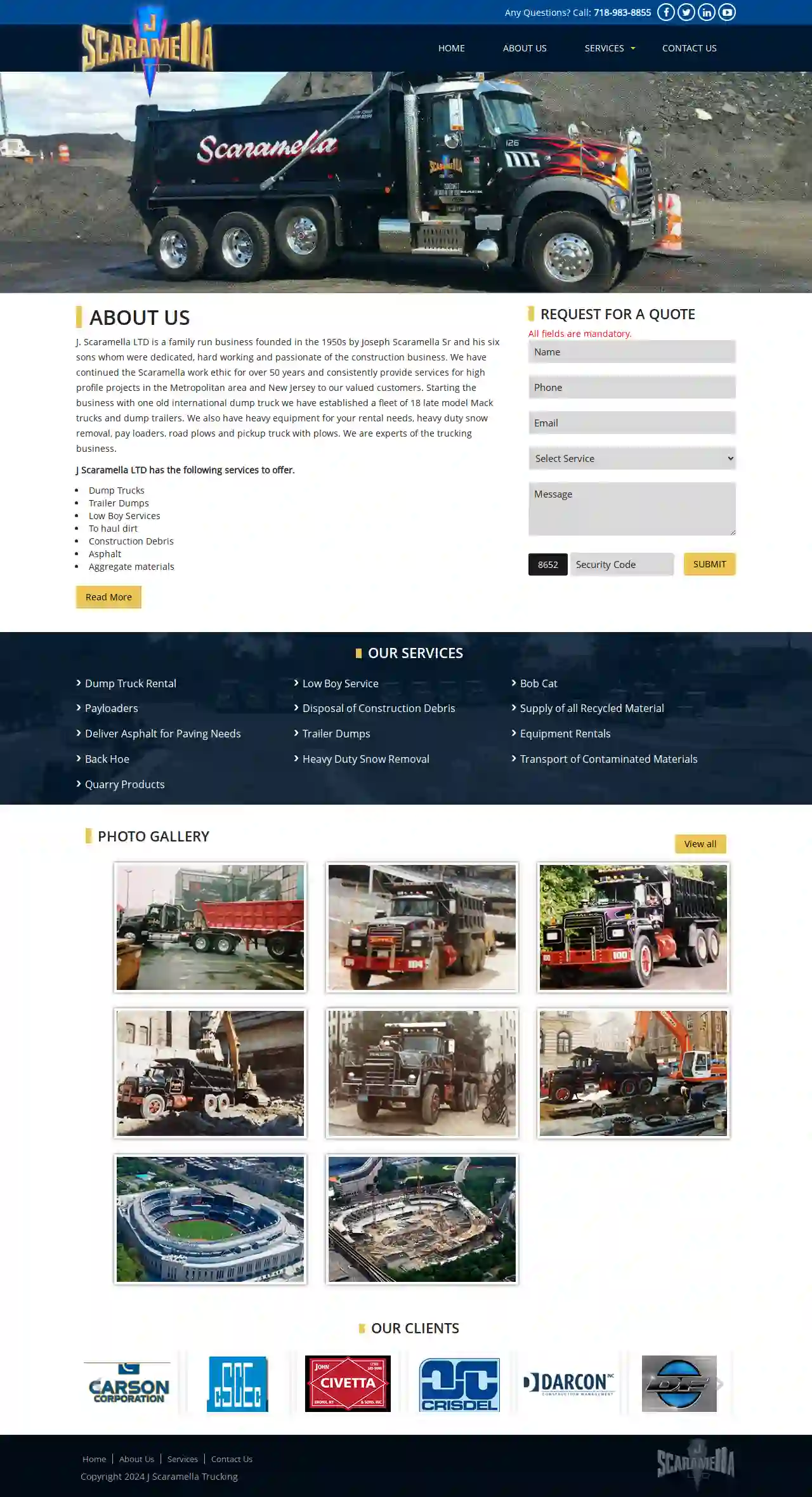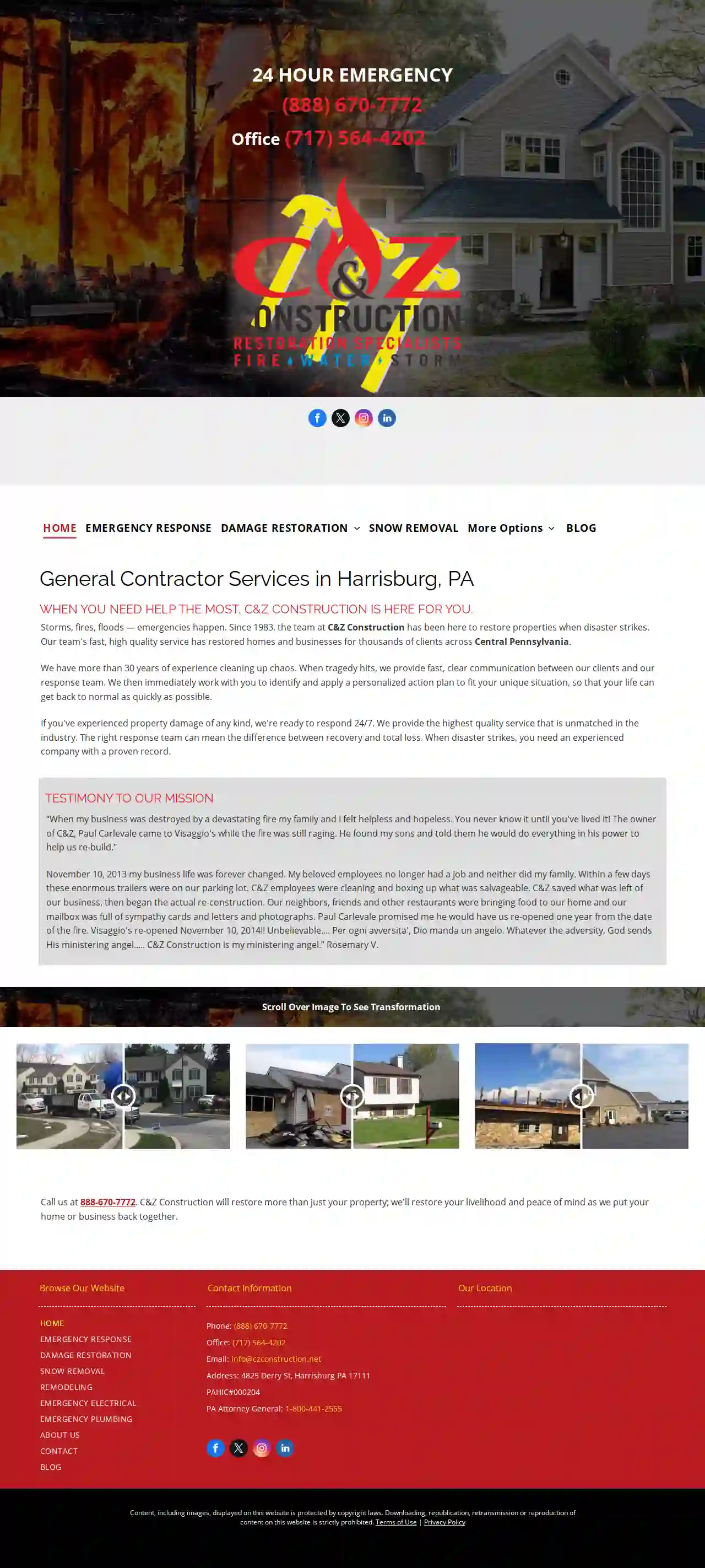Demolition Contractors Lower Merion
Top 10 Demolition Contractors Near Me in Lower Merion
Receive multiple Demolition Experts quotes for your project today! Compare profiles, reviews, accreditations, portfolio, etc... and choose the best deal.

Earthcore
11 reviews455 Fairview Chapel Road, Birdsboro, 19508, USFor decades, engineers, contractors, and property owners alike have come to rely on Earthcore as the go-to resource to resolve their toughest drilling and foundation construction challenges. Headquartered in Birdsboro, PA, we deploy our crews across the Northeast and Mid-atlantic regions. With a proven track record of documented safety, certifications, and successful execution, Earthcore brings highly-experienced operators and a large, diverse fleet of powerful rigs to job-sites rapidly to get the job done right. We invite you to do a little digging of your own to learn how Earthcore may be the perfect solution for your project. Be it test borings, soil stabilization, or assistance with specialty foundation construction, we do it all.
- Services
- Why Us?
- Gallery
Get Quote
Kuharchik Construction
4.428 reviews420 Schooley Ave, Exeter, 18643, USWE ARE KUHARCHIK CONSTRUCTION. Providing superior electrical contracting services throughout Pennsylvania since 1973. We’re local, we’re family owned, we’re union! Kuharchik is your first choice in Electrical Contracting. From Highway Signing & Lighting to Foundation Installation, we take pride in every job that we do.
- Services
- Why Us?
- Gallery
Get Quote
Kirby Kitner Excavating & Paving
4.86 reviews7214 Spring Road, New Bloomfield, USWelcome to Kirby Kitner Excavating! Whether it is site prep for new structures, foundations, road building, graves sites, drainage or septic systems, Kirby consults with all customers personally and is present on all job sites to assure you of quality workmanship. Our staff is professional, experienced, and dependable. We are celebrating our 39th year in business. Kirby Kitner Excavating is a local, family-owned business. Our company is fully insured and we give free estimates. Kirby Kitner Excavating is a DOT Registered Motor Carrier: USDOT 2291670 and a Registered PA Contractor: # PA027056. We are members of the Perry County Chamber of Commerce. Kirby Kitner Excavating is located at 7214 Spring Road, New Bloomfield, PA.
- Services
- Why Us?
- Gallery
Get Quote
CAG Construction Corp.
30 Summit Ave., Staten Island, 10306, USCAG Construction: Your Trusted Partner for Concrete Construction and Site Work CAG Construction is a family-run business established in 2007, specializing in all phases of concrete construction and site work. We are committed to delivering projects within budget, on time, and with the utmost professionalism. Our team has the experience and expertise to work seamlessly with project managers and design teams, ensuring a smooth construction process. Our Commitment to Excellence Edward Gonzalez, our founder, is a graduate of the NYC Small Business Services Construction Mentorship Program, NYC SBS Bond Readiness Program, and the New York City Economic Development Corporation – Construct NYC Program. This comprehensive training has equipped us with the knowledge and skills to deliver exceptional results. Certifications and Accreditations We are proud to be a New York City MBE Certified company, demonstrating our commitment to diversity and inclusion. We are also SCA Approved and a member of the National Association of Minority Contractors (NAMC), further solidifying our dedication to industry standards and ethical practices.
- Services
- Why Us?
- Gallery
Get Quote
NYC Excavation Contractor
York, USAbout NYC Excavation Contractor NYC Excavation Contractor is a premier provider of excavation services in New York City. With a dedicated team of professionals and top-of-the-line equipment, we deliver unmatched quality in every project we undertake. Our commitment to excellence has earned us a reputation for delivering exceptional results. From clearing land to precision grading, we have successfully completed numerous projects, exceeding client expectations at every turn. Our Commitment Missions & Values Driven by Purpose Our Mission To provide reliable, efficient, and top-quality excavation services to our clients, ensuring their projects are successful and their visions are brought to life. Core Principles Our Values We uphold integrity, professionalism, and client satisfaction as the cornerstones of our operations, fostering relationships based on trust, transparency, and mutual respect. Our Journey Company History Founded in the heart of NYC, NYC Excavation Contractor has grown from humble beginnings to become a trusted name in the industry. With a track record of excellence, we continue to push boundaries and set new standards. Over the years, we have expanded our services, improved our techniques, and embraced innovation to stay at the forefront of the excavation sector. Our journey is defined by continuous growth and a relentless pursuit of perfection.
- Services
- Why Us?
- Testimonials
- Gallery
Get Quote
Big Horn Excavating LLC
Lykens, PA, 17048, USExcavation Company It doesn’t matter whether an excavation job is straightforward or complex, every project could benefit from professionalism—and that is why so many people look to Big Horn Excavating LLC when they are in need. Offering exceptional excavation services, we are the contractors that set big projects in motion. We work alongside landscapers, homeowners, and general contractors on a regular basis. So whether you are looking for someone to prepare a site for basement construction or dredge silt and muck from a community pond, we are the ones you can count on. Skilled in All Excavation Services We pride ourselves on our versatile nature. Our contractors might find themselves offering services to aid in installing a stormwater drain one day, only to be excavating earth and topsoil for a backyard pond the next day. Some of the additional excavation services we offer include: Earth moving Grading Rock removal Basement excavation Site preparation services And more With so many services at your disposal, you will never have to look to another excavation team ever again. Reach out to us today to learn more about the services we offer. All the Excavation Equipment Needed Every excavation project is different. Thankfully, we are always prepared for whatever obstacle comes our way. Between our years of experience and vast storehouse of equipment, our accredited team always rises to the occasion. We move mountains for our clients—along with topsoil, earth, rock, and debris. When your upcoming project calls for an excavator, look to us. Serving the Entire Community We deliver grading and excavation solutions for industries and individuals of all distinctions. Some of the professionals we commonly work with include: Real estate developers Municipal construction operations Engineers Architecture firms General contractors Utility companies Our versatile nature allows us to envision the entire scope of our client’s construction projects. In doing so, we lay the best foundation possible for all the work to come. If you would like to learn more about our services, please feel free to contact our offices at your convenience. Excavation and Excellent Customer Service When it comes to your construction projects, you only want professionals on site. Rest assured, you will absolutely love our professional yet personable approach to excavation. We are always happy to answer your questions and address any concerns you might have.
- Services
- Why Us?
- Gallery
Get Quote
Rock Solid Landscaping and Masonry Design, Inc
3.723 reviews516 Industrial Loop, Staten Island, 10309, USAward winning landscape design & build since 1998 Full Service Landscape Architects Award winning landscape design & build since 1998 Full Service Landscape Architects Award winning landscape design & build since 1998 Full Service Landscape Architects Rock Solid Landscape and Masonry Design Inc specializes in designing and creating your dream home. Being experts in both hardscape and landscape design in Staten Island, we will help build the concept from your vision and ideas, and bring them to life. From start to finish, we work together with each of our clients to ensure that the work that is being done matches the concept that they dreamed up. Let Rock Solid Landscape and Masonry Design Inc create your next landscape masterpiece. Rock Solid Yards is the winner of Two 2010 Staten Island Chamber of Commerce Building Awards for: ROCK SOLID LANDSCAPE AND MASONRY DESIGN INC. more about us Serving the Tri-State area since 1998. MICHAEL IZZO OWNER/MASTER DESIGNER Michael Izzo has over 20 years of Landscape and Masonry Construction experience. He built Rock Solid Landscape and Masonry Design, Inc. from the ground up and he attributes his success to practicing good old fashioned business ethics and promoting a company philosophy of “exceeding customer expectations”. “Customers will return to and promote a business that consistently shows up and delivers exceptional quality projects on schedule and on budget. It’s really that simple.” Trust us for your masonry design and landscaping in Staten Island
- Services
- Why Us?
- Our Team
- Testimonials
- Gallery
Get Quote
RR Plumbing Roto-Rooter
4.8978 reviewsStaten Island, USStaten Island Plumbers Near You Plumbing & Drain Solutions: Licensed Staten Island Plumber Providing 24/7 Emergency Plumbing and Drain Services If you are currently looking for a reputable plumber in Staten Island that can meet your plumbing needs quickly and correctly the first time, then look no further. For over 85 years, RR Plumbing Roto-Rooter has been skillfully meeting the plumbing and drain cleaning needs of homes and businesses throughout the entire Staten Island, NY area. Our licensed and insured plumbers can handle commercial, residential, and emergency plumbing and drain cleaning needs of all sizes and complexities, including toilet repairs, blocked sinks, clogged shower drain repairs, sump pump replacements, and water heater installations. Our affordable plumbing services are also available 24/7 so that you do not have to wait to get the solutions you need.
- Services
- Why Us?
- Testimonials
- Gallery
Get Quote
Scaramella Trucking
3.76 reviewsYork, USAbout Us J. Scaramella LTD is a family-run business founded in the 1950s by Joseph Scaramella Sr and his six sons, who were dedicated, hard-working, and passionate about the construction business. We have continued the Scaramella work ethic for over 50 years and consistently provide services for high-profile projects in the Metropolitan area and New Jersey to our valued customers. Starting the business with one old international dump truck, we have established a fleet of 18 late-model Mack trucks and dump trailers. We also have heavy equipment for your rental needs, heavy-duty snow removal, pay loaders, road plows, and pickup trucks with plows. We are experts in the trucking business.
- Services
- Why Us?
- Gallery
Get Quote
C&Z Construction
4.332 reviews4825 Derry St, Harrisburg PA, Harrisburg, 17111, USWhen you need help the most, C&Z Construction is here for you. Storms, fires, floods — emergencies happen. Since 1983, the team at C&Z Construction has been here to restore properties when disaster strikes. Our team's fast, high quality service has restored homes and businesses for thousands of clients across Central Pennsylvania. We have more than 30 years of experience cleaning up chaos. When tragedy hits, we provide fast, clear communication between our clients and our response team. We then immediately work with you to identify and apply a personalized action plan to fit your unique situation, so that your life can get back to normal as quickly as possible. If you've experienced property damage of any kind, we're ready to respond 24/7. We provide the highest quality service that is unmatched in the industry. The right response team can mean the difference between recovery and total loss. When disaster strikes, you need an experienced company with a proven record. TESTIMONY TO OUR MISSION “When my business was destroyed by a devastating fire my family and I felt helpless and hopeless. You never know it until you've lived it! The owner of C&Z, Paul Carlevale came to Visaggio's while the fire was still raging. He found my sons and told them he would do everything in his power to help us re-build." November 10, 2013 my business life was forever changed. My beloved employees no longer had a job and neither did my family. Within a few days these enormous trailers were on our parking lot. C&Z employees were cleaning and boxing up what was salvageable. C&Z saved what was left of our business, then began the actual re-construction. Our neighbors, friends and other restaurants were bringing food to our home and our mailbox was full of sympathy cards and letters and photographs. Paul Carlevale promised me he would have us re-opened one year from the date of the fire. Visaggio's re-opened November 10, 2014!! Unbelievable.... Per ogni avversita', Dio manda un angelo. Whatever the adversity, God sends His ministering angel..... C&Z Construction is my ministering angel.” Rosemary V.
- Services
- Why Us?
- Testimonials
- Gallery
Get Quote
Over 22,076+ Excavation Pros on our directory
Our excavation companies operate in Lower Merion & surrounding areas!
ExcavationHQ has curated and vetted the Best Excavation Companies in and around Lower Merion. Find the most trustworthy contractor today.
Frequently Asked Questions About Demolition Contractors
- Project Assessment: The demolition contractor evaluates the structure, site conditions, and project requirements.
- Permitting: Obtain necessary demolition permits from local authorities.
- Site Preparation: Secure the site, disconnect utilities, and remove any valuable or reusable items.
- Hazardous Material Abatement: Professionally remove asbestos, lead paint, or other hazardous materials if present.
- Demolition: Execute the chosen demolition method, bringing down the structure safely and efficiently.
- Debris Removal and Site Cleanup: Sort, process, and dispose of demolition debris responsibly. Clean up the site to prepare it for future use.
- Enclosure: Sealing off the asbestos-containing material to prevent fiber release.
- Encapsulation: Coating the asbestos-containing material with a sealant to bind the fibers.
- Removal: Carefully removing the asbestos-containing material and disposing of it safely.
How do I find demolition contractors near me?
What is a demolition bond?
What are the steps involved in a typical demolition process?
What are the different methods of asbestos abatement?
How do I find demolition contractors near me?
What is a demolition bond?
What are the steps involved in a typical demolition process?
- Project Assessment: The demolition contractor evaluates the structure, site conditions, and project requirements.
- Permitting: Obtain necessary demolition permits from local authorities.
- Site Preparation: Secure the site, disconnect utilities, and remove any valuable or reusable items.
- Hazardous Material Abatement: Professionally remove asbestos, lead paint, or other hazardous materials if present.
- Demolition: Execute the chosen demolition method, bringing down the structure safely and efficiently.
- Debris Removal and Site Cleanup: Sort, process, and dispose of demolition debris responsibly. Clean up the site to prepare it for future use.
What are the different methods of asbestos abatement?
- Enclosure: Sealing off the asbestos-containing material to prevent fiber release.
- Encapsulation: Coating the asbestos-containing material with a sealant to bind the fibers.
- Removal: Carefully removing the asbestos-containing material and disposing of it safely.